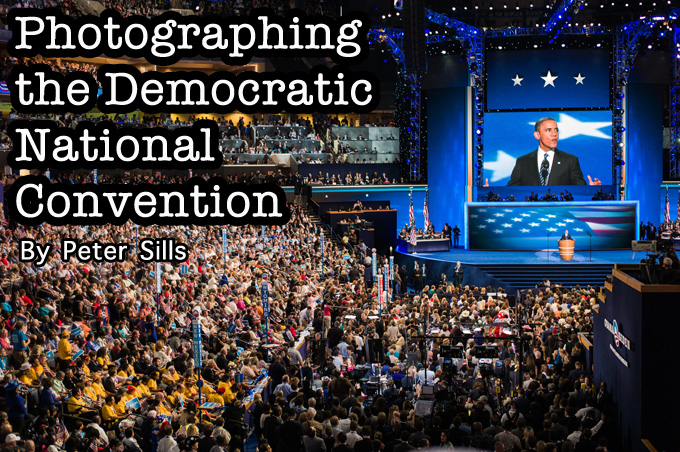
Left-Brain vs. Right Brain: Photographing the Democratic National Convention
By Peter Sills
For the last three election cycles, I have had the privilege to photograph the Democratic National Convention. It has been a wonderful experience, meeting interesting people, celebrities and politicians alike. Unlike the vast array of photojournalists at the event, I was hired directly by the Democratic National Convention. My job has been to document the event for the archives. This has allowed me to shoot alongside photographers from the UP, Reuters, etc. as well as venture backstage and capture the infrastructure of the event itself.
I have always used my trusty Canon gear when embarking on such a rigorous assignment. This time, through the efforts of Mark Abraham of the Washington Press Corp., and Scott Andrews of Canon, I was able to borrow a new Canon 5D MkIII and a bevy of lenses, including the amazing 400mm f/2.8 L IS.
I also brought with me my new Leica M9-P and the triumvirate of lenses: 35mm Summilux, 50mm Summilux and 90mm Summicron (the entire kit weighs less than half of the Canon 400mm alone). Unlike the gear which was on loan from Canon, this was MY camera, and I was very anxious to use it to shoot something different from the standard convention photos.
Having used the Leica for only a few months, I knew it would be impossible to photograph the convention in my usual manner. Distances were too long for a meager 90mm, and things moved too quickly for manual focus. However, there was a lot for which the standard Canon kit was inappropriate and the Leica ideal; those close-in moments, those more contemplative moments, the more subjective moments. These were the shots I had never really tried to get at a convention before.
[ad#Adsense Blog Sq Embed Image]
However, before continuing, let me step back in time a bit.
I turned 50 this year. I have been a photographer since I was 16 years old. My professional life was outside of photography, so I had put it aside for a number of years, only to pick it up again once the digital age of photography began. I have always used Canon gear, only once “dabbling” with Nikon before returning to the fold.
Well, this year I began to become bored with photography. It was not that great images didn’t excite me any more – they did. I still bought plenty of photo books and I loved going through each new issue of LensWork and American Photography. What was wrong?
As I examined it, photography was becoming more and more “Left Brain”. It was all about High-ISO noise, Image Stabilization, Frames per Second, Megapixels, etc. The camera was becoming more and more of a computer. Newer cameras now have the ability to “re-crop” your images into more pleasing compositions, scene modes detect how the entire camera should behave with little to no user interaction, face detection chooses the focus, in camera HDR provides for the “artistic-look”, etc.
I started looking through my images over the last twenty or so years. Back in the days of film, I would take one image of a subject and move on. I would think about the image, compose it, consider it carefully, and press the shutter. The more I went on, up until today, I noticed that the time spent on an image decreased while the number of images increased. With digital, I could just press the button and worry about it later. It was less and less about taking an image, and more about choosing one later from the 15, 20, or 30 that had been shot.
It was becoming almost impossible to take a “bad” shot. The last straw came when I began to see DSLRs everywhere. I saw an older woman taking photos of what I can only assume were her grandchildren in a park. She was toting a Nikon DSLR and a couple of lenses. What was I doing?
After a lot of soul-searching and reading on the net, I came across Steve’s site. While I had always heard of Leica, I had never used one. Perhaps this was it? I ordered one, along with a 50mm lens and felt my “Right Brain” re-engage. I was hooked.
With the Leica, I was once again studying my subject as opposed to simply trying to “get the shot.” I thought about aperture and exposure, instead of letting the camera do the thinking for me. I pre-focused and waited patiently for the moment I knew was coming, rather than simply grabbing a long sequence of shots and choosing the right one later. I even chose my lens based on what I was shooting and the look I wanted, where previously I simply bolted on a zoom lens and just had at it.
I use the analogy of the Portrait Painter and the House Painter. Both are called “painters” and both are capable of producing tremendous work. However, one relies on the technical nature of the tools they are using (such as rollers and sprayers) as well as the objective means by which their work is judged. The other requires more refined tools for their work, which is judged on a far more subjective basis. One lasts through the ages, the other until another coat is needed.
Enough philosophizing, back to the convention.
Now, when your job/life depends upon “getting the shot” there is nothing wrong with a camera and setup which makes absolutely certain that this will happen. For this task, the Canon 5D MkIII is the best camera I have ever used. Its focus and metering is spot on. It’s extremely fast, only bested by the Canon 1Dx. If you need the shot, aim it in the general direction of what you want to capture, set the camera to “P” and press and hold the shutter until the buffer is full. Trust me, the shot is in there.
For those shots I “had to get” this is what I used; as did all of the other professional photographers from the New York Times, Washington Post and the other news services. We all got the same shots. Side-by-side, same equipment, firing like mad when there was a gesture or look we thought our employers would appreciate. With few exceptions, if you took all of the photographs taken by everyone and mixed them up, no one could claim their own.
During the week I was in Charlotte for the convention, I shot more than 6,000 images. Of the images I shot, only about 400 or so were shot using the Leica. These were my images. These were the ones inside the convention, outside the convention, at the Bill Clinton party, the protest rally, or just heading home at the end of the day. These were for me.
The Leica makes me think. It makes me plan. It makes me create rather than capture.
Given its size, the Leica is with me most of the time. Given its simplicity, it has become the tool of choice when photographing for myself. I am far from being as proficient with it as I am with my Canon gear (after all I’ve been using Canon for decades), but the Leica is the camera I now prefer to use. Is it for everything? Obviously not.
Can the Leica compete in the “land of the giants,” the 400mm, 500mm and greater lenses? In a word, no. When the shot has to be in perfect focus, clear in almost no light, and of that microsecond moment that disappears in an instant – the Leica would not be my first choice – we have computers for that; computers made by Canon, Nikon and now Sony.
At the end of the day, I have edited most of my 6,000 images, handed them in to the convention, and posted some to my stock agency. Those that I printed, those that will go on my walls, those that I am the most proud of, came from my Leica.
My Right-Brain is engaged once again, creating images which will hopefully last.
Next?
I’m off to go find some abandoned Steel Mills! (and thinking of a Leica MP!)
Thanks Steve for letting me ramble on so. Shooting with the Leica has been a joy. Keep up the great work.
(Thank YOU Peter!!!)
Now the images:
Allies
90mm, ISO 160, f/6.7, 1/250 sec.
The police were brought in from around the state to deal with the protest march. I focused on the lines which this image sets up, as well as the banner with the word “Allies” on it. Note the name of the street is West Trade, though everyone mistakes it for World Trade. An interesting juxtaposition.
–
Castles in the Sand
50mm, ISO 1250, f/8, 1/90 sec.
Designed to promote tourism to Myrtle Beach, this enourmous sculpture of Barak Obama was built leading up to the convention. Situated so all of the delegates would have to pass by, it presents an interesting portrait of the president, both massive in scale, yet ephemeral in composition.
–
Charlotte, Night
50mm, ISO 1600, f/2, 1/25 sec. EV -.7
Walking out of the convention late one night, looking up to see this brilliantly lit building dwarfed by two adjacent and boring office complexes.
–
Chris Matthews, MSNBC
50mm, ISO 500, f/2.8, 1/60 sec.
One of my favorite images from the convention. MSNBC had set up their own pavillion in an outside mall. Climbing to the top floor and looking down on to the Chris Matthews show. The two separate worlds, one on stage – calm, back to the audience, to the camera – the other in the audience, all jumbled together, no single focus, almost without purpose, drawn to the spectacle.
–
Girl Power
90mm, ISO 160, f/5.7, 1/180 sec.
Taken during the protest march. Many, many messages in the crowd. Almost too many to grasp any continuity in the meaning. Spotted this girl being held aloft. Always wonder if she has any idea regarding the meaning of the sign she carries.
–
National Guard Rail
90mm, ISO 160, f/2.4, 1/180 sec.
North Carolina police officer (more than likely brought in from a surrounding district) awaits the protesters.
–
On the Big Screen
50mm, ISO 400, f/2.8, 1/60 sec., EV -.3
Obama speaks to the convention. While not as effective in “getting the shot” as a 500mm from the same location, the Leica does a much better job of getting the feel of the event. The house was packed. Walking around with the M9 allowed me to move more freely through the crowd.
–
Pool Feed
50mm, ISO 500, f/2.8, 1/90 sec.
These are three of the Pool Feed cameras, cameras which supply video to all of the networks of the main event. During rehearsal, when the stage is blank, the operators are still there. There is often even time to catch up on one’s reading, as seen here.
–
Step Right Up
50mm, ISO 400, f/1.7, 1/90 sec., EV -1
Managed to wrangle an invite to the private Bill Clinton party for the State of Arkansas. As usual, Bill was quite late in making an appearance. His speech was more of a talk, preparation for his speech on the floor the next day. I waited to see that Clinton “sparkle” which he is well known for. Standing at the platform, he seemed almost the consumate carnival barker, the reason for the toning of the photo as shown.
–
Waiting for the Shot
35mm, ISO 500, f/2.4, 1/60 sec.
I was standing in front of the opening to the floor a few days before the convention began and this photographer strode up, he was shooting everything (though there was really nothing to shoot yet). Suddenly he dropped to the floor and started shooting the entrance as if the King of Siam was coming through it. He took so many shots that I had plenty of time to take out my Leica, bolt on the 35mm and shoot him. I took two shots. I think he must have had thirty or more.
–
Wherever You Hand Your Hat
50mm, ISO 800, f/4, 1/60 sec., EV +.3
One of my favorites. The last day of the convention, heading back to my hotel. On the transit sign, the local police officer who was assigned to guard this entrance, had hung his hat and bag. He was no where to be seen. It was over.

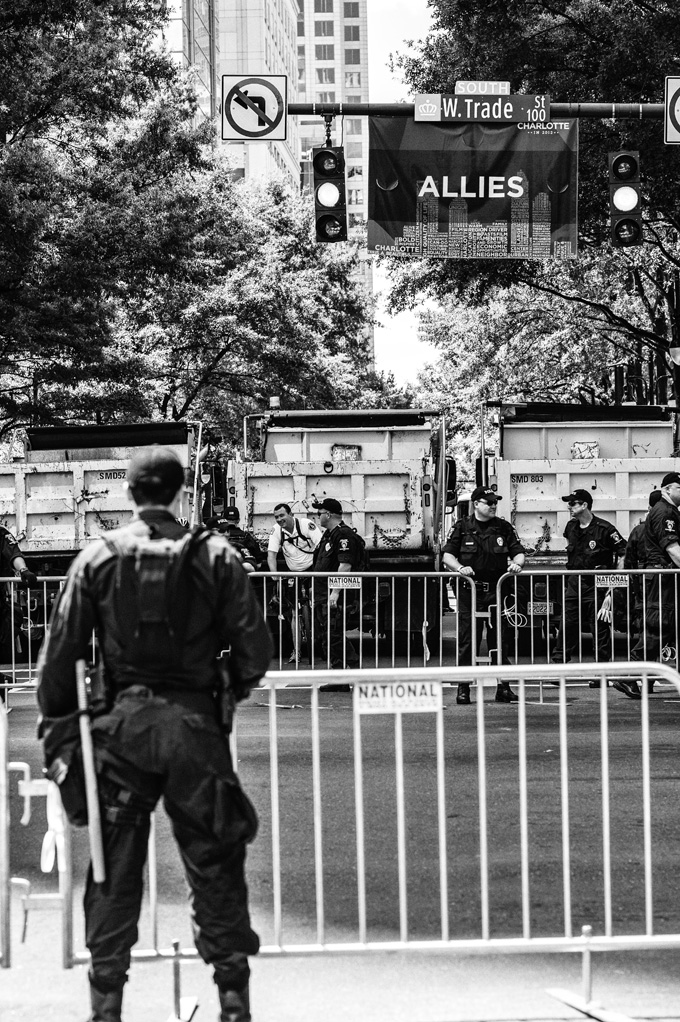
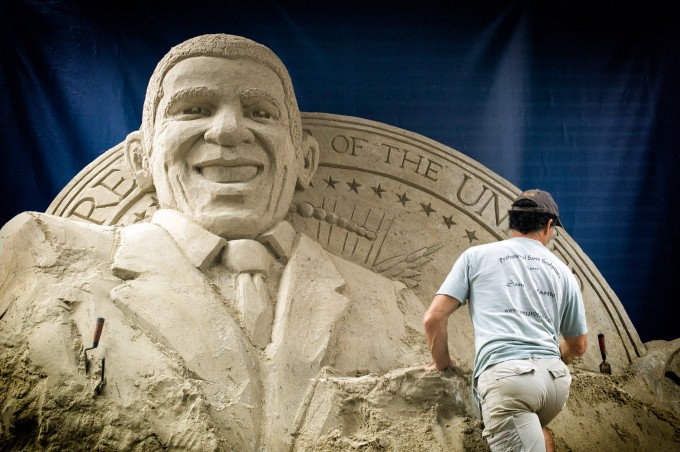
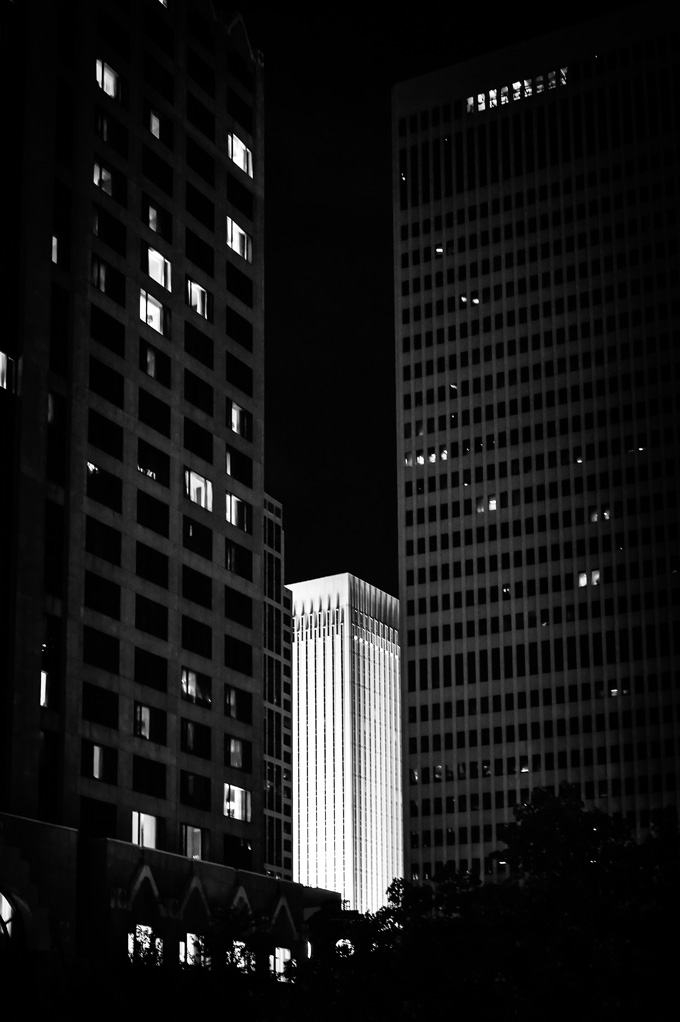
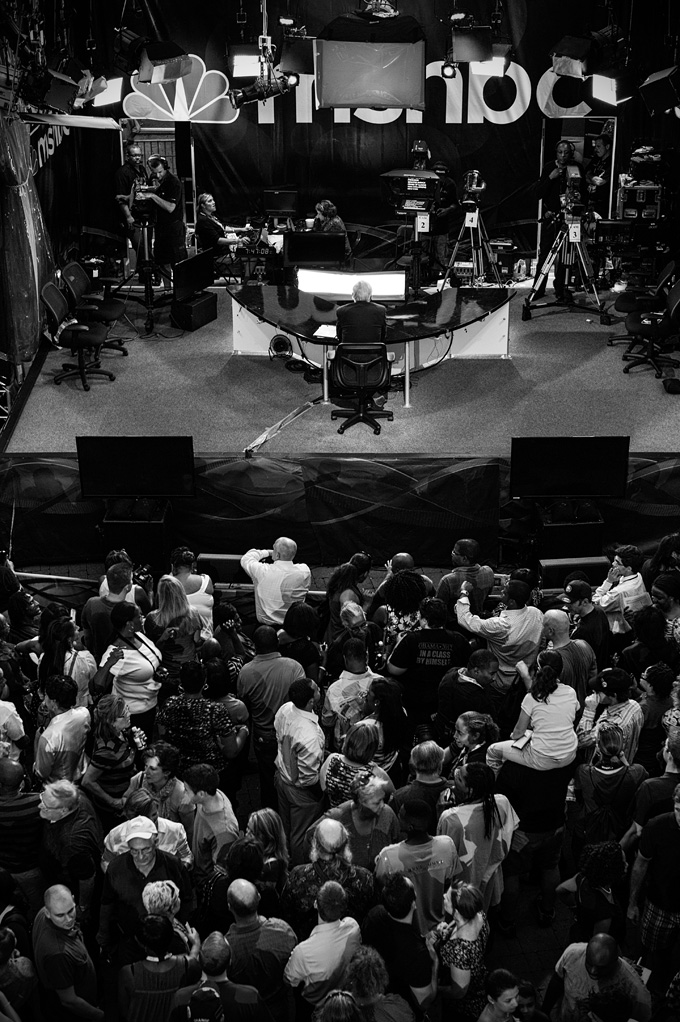
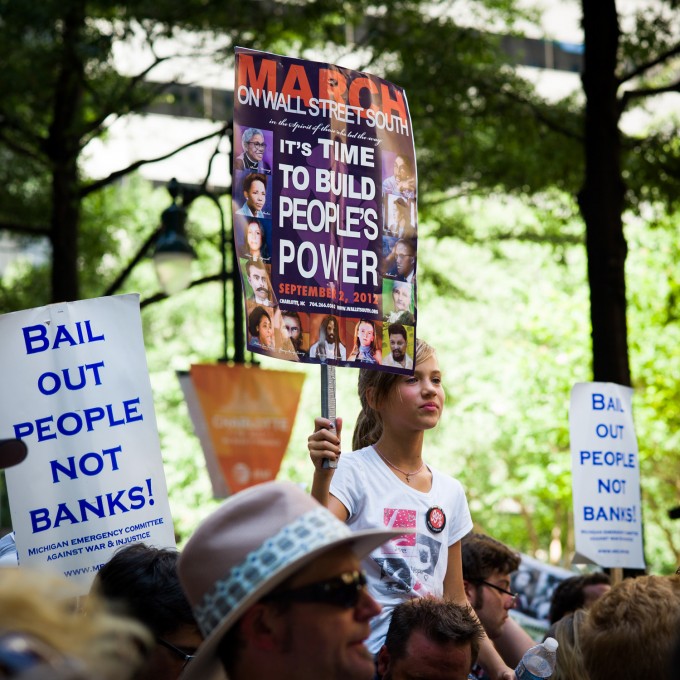
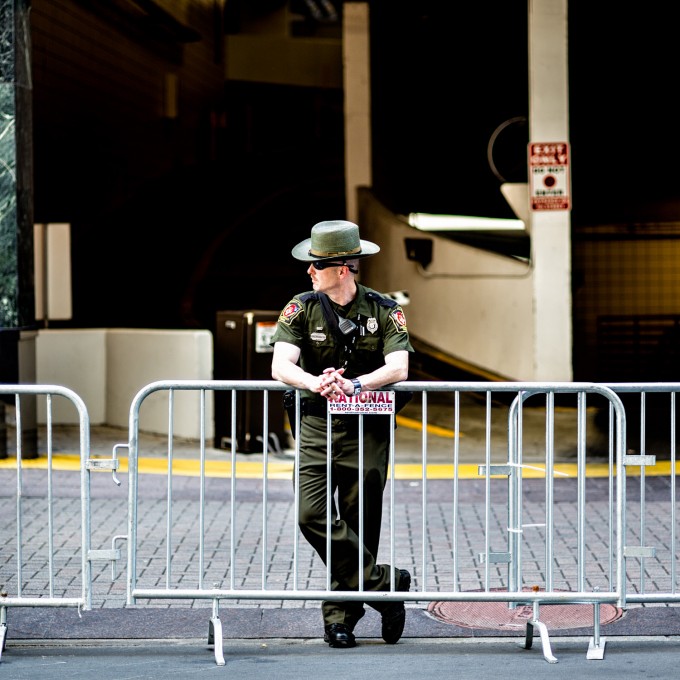
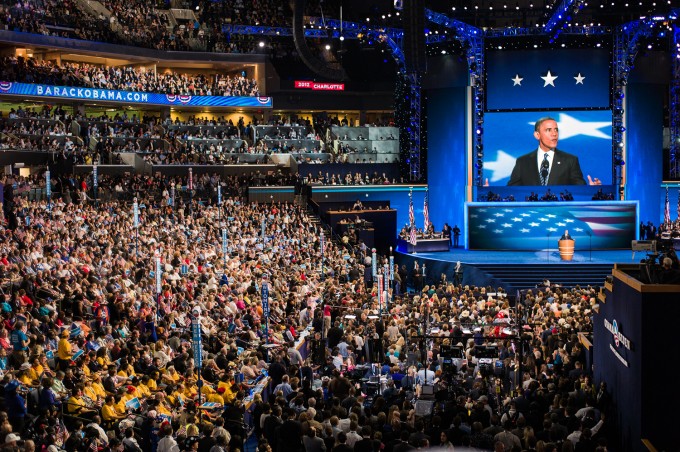
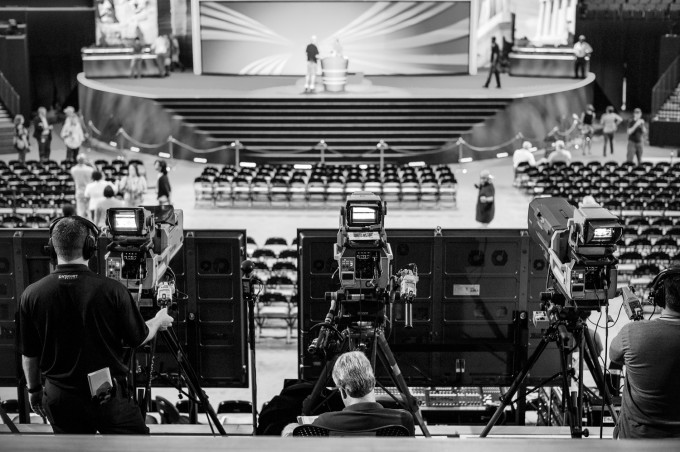
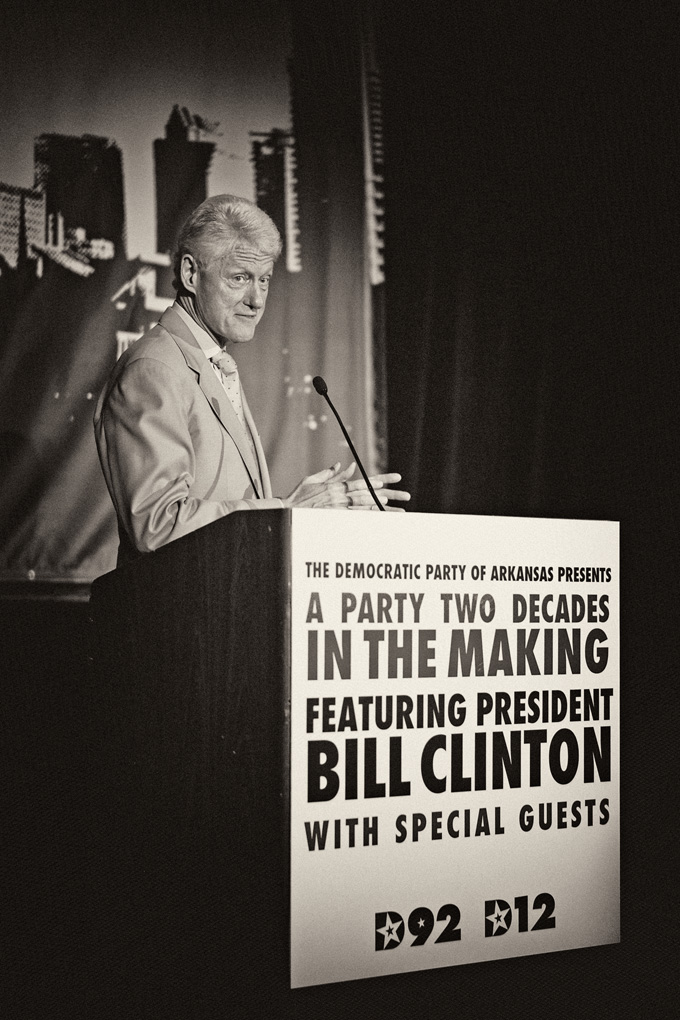
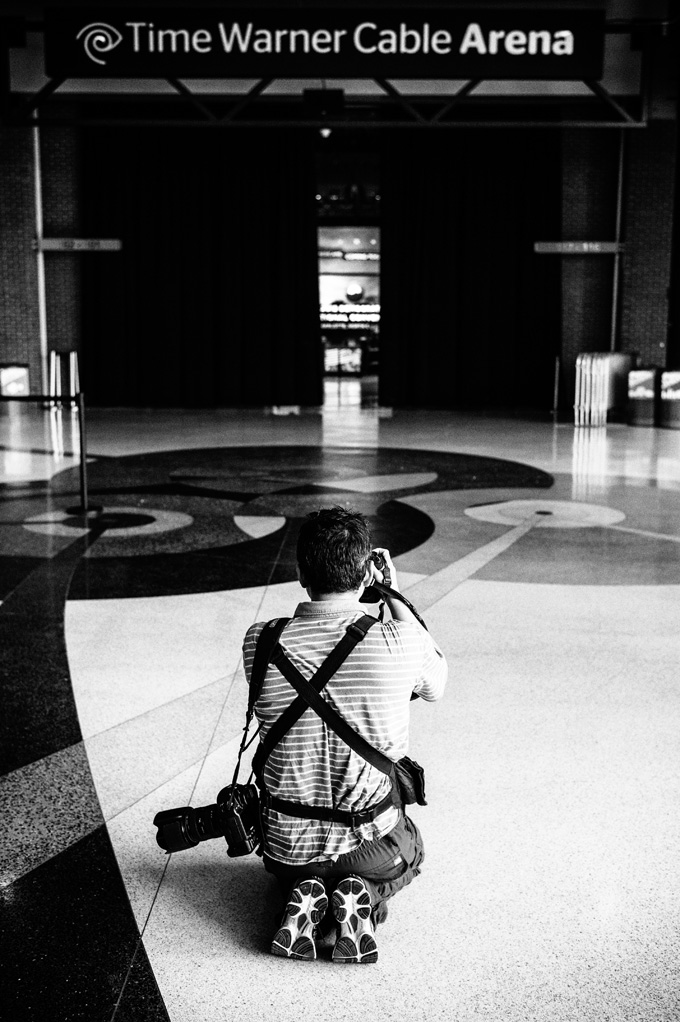
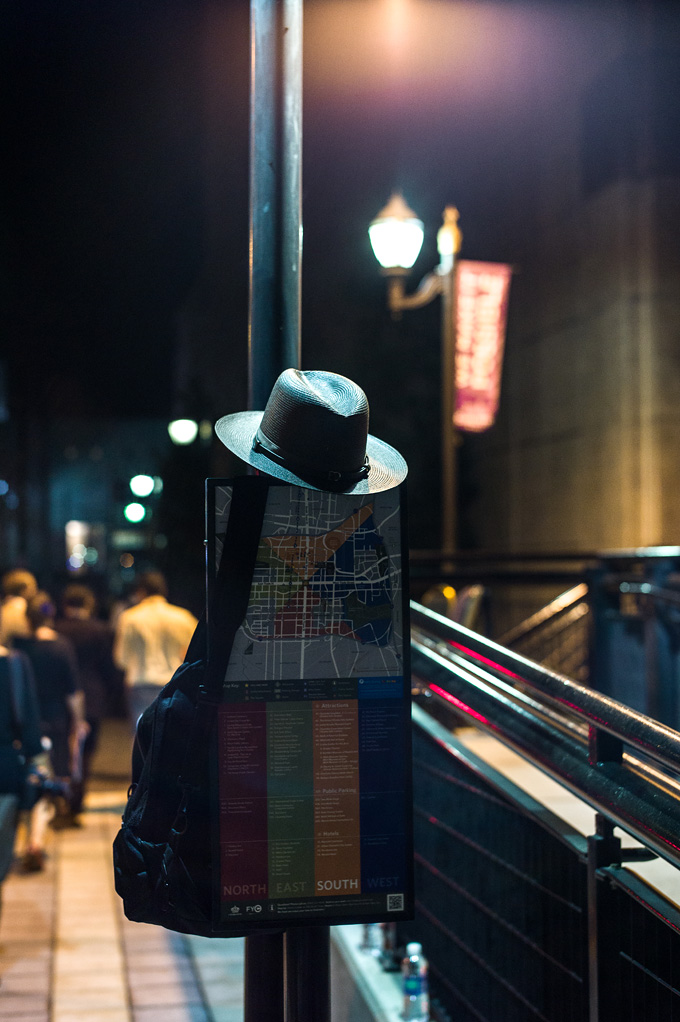


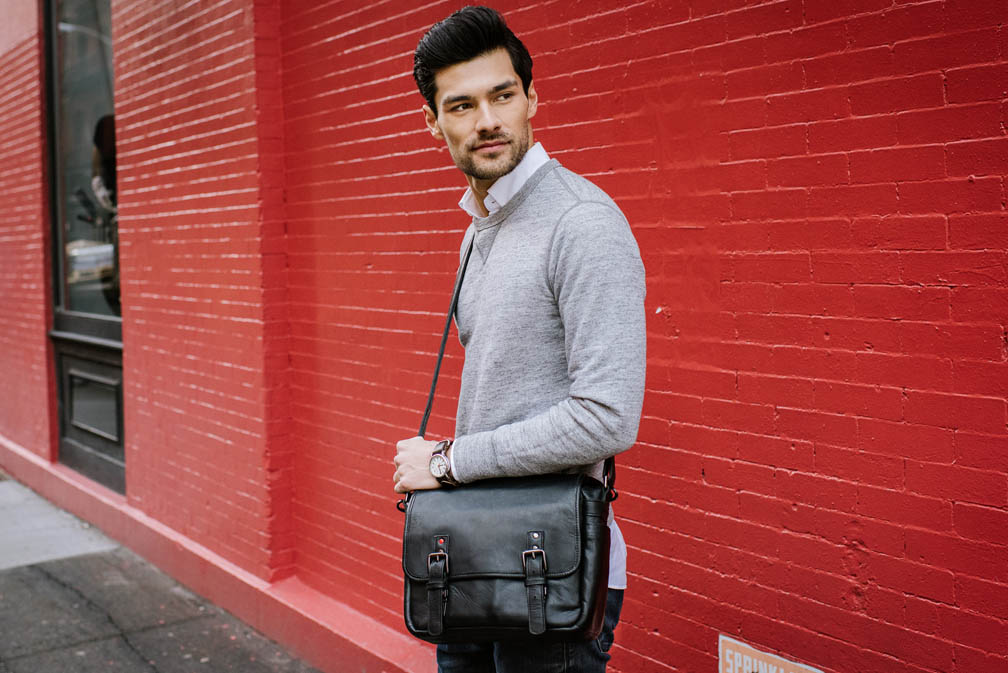
Read it. However, one has the ability to make one’s own artistic choices as well. Looking at the images on the web is not a good way to evaluate.
your welcome, I would like you recommend to read the classic book the Negative of Ansel Adam. Even in the digital age a must read.
Appreciate the feedback. To each their own, I guess. I am a fan of a bit stronger contrast as I like to separate the layers in the image a bit more. However, I don’t think it is too strong, as the histogram is not overblown, etc. It could also be your viewing environment, but thanks for the feedback.
The contrast is to harsh, not consistent in your photos and very unbalanced, very noticeable with the black and white photos. But this is not job for a photographer, but more for a professional photoshop wizard. But you don’t see this in your photos?
What don’t you like about my processing 😉
Thanks for your reply. No doubt that photographers adapt their habits to the situation and to the abilities of their camera, but I’m not sure that a political event *requires* that the camera be used a certain way, or that a photojournalist has to do what every other photojournalist at an event does. I see from the White House photo stream on Flickr that the President’s photographer always sets his camera on Manual, no matter what event he is photographing, and uses primes lenses most of the time. The Leica M does enforce a kind of discipline by virtue of having limited automation, but I think that any photographer can decide to apply the same disciplines with a DSLR: studying the subject, thinking about aperture and exposure (not letting the camera do the thinking), waiting patiently, choosing the lens based on the look one wants, etc.
You know composition so clearly, all the photos are of very high quality (except for the processing but who cares). If I was in your position I would have swapped the Leica for a nice 4×5 camera. Imagine the Obama photo on 4×5!
It’s a brand. A very strong one and I think that’s why people love talking about their Leica!
I think you misunderstand. Photojounalistic shots, such as those at a political event such as the convention, requires allowing the camera to make many of the decisions. I don’t know of any journalist at an event such as this or the Olympics or similar, who sets their camera on Manual.
Again the issue is not that you can’t get great shots on any camera, it is about using the right tool for the right job. In a tight situation such as a political convention, the more the camera can do the more the photojournalist will rely upon it – and thus the more the photojournalist becomes just like the one standing next to him.
The rangefinder has its advantages, but the alleged disadvantages of the DSLR sometimes just reflect the bad habits of the photographer … habits which the photographer can easily fix. This paragraph is a good example:
“With the Leica, I was once again studying my subject as opposed to simply trying to ‘get the shot.’ I thought about aperture and exposure, instead of letting the camera do the thinking for me. I pre-focused and waited patiently for the moment I knew was coming, rather than simply grabbing a long sequence of shots and choosing the right one later. I even chose my lens based on what I was shooting and the look I wanted, where previously I simply bolted on a zoom lens and just had at it.”
Why wouldn’t one think about aperture, exposure, the moment, lens choice, etc. with a DSLR? All of that good “With the Leica” stuff can (and should) be done with a DSLR too. It doesn’t take $20K+ in Leica gear to fix bad habits.
I have similar experience path with the RF and DSL equipments like Peter’s. I ask myself this question from time to time. I can set the DSL all manual to reduce the degree of automation. But it seems that once I use the auto everything camera I auto everything all the way. Then I praise the M9 for all its beauties an contemplate each shot as much as I should. What a self inflicting dilemma.
I too find this practice amongst Leica users odd. They need to come up with some sort of non-functional intangible to justify their using Leica. Perhaps it’s a market of people who can’t think on their own and need a camera to initiate the thinking process. I’ve been shooting rangefinders on and off for 52 years. While I enjoy their attributes of build quality, lens selection and size, I certainly don’t think any different when I’m using a dslr. Good marketing to a target audience.
Better check your iPad. I did not notice any issue on my ipad3 and I just picked up my wife’s iPad 1. Gorgeous, far more so than on our Air or iMac displays, as usual.
Perhaps. But I think it’s you who has misinterpreted Don’s analogy.
No worries, was just an amused remark on the primitive nature of the user interface on the M9. I agree that the M9 is a piece of electronic equipment with an image processor and a sensor at its heart.
Nonetheless, it doesn’t feel digital at all to me in comparison to a DSLR – you can quite happily shoot all day without reference to the screen.
Frank, Andy’s right, the point I’m making is that using a Rangefinder you look at the scene a different way and take shots you wouldn’t of even thought of taking with a AF camera. That and with a properly calibrated rangefinder (and a bit of practice) you’ll get more accurate focus than relying upon the AF from a camera.
The sensor produces quite nice results too…
I also like Leica, but get a little tired of justifications for having a Leica vs.dslr for different photography style. I think primes vs. zoom are a more important distinction. And by the way, my dslr with three excellent primes is not bigger/heavier than a similar Leica kit.
You’re sadly missing his point.
He’s referring to the press photographers with their “spray and pray and maybe I’ll get paid” methodologies.
Your statement just further reinforces the Peter’s message of assessing the method, lens choice, and composition of a shot before pulling the trigger. You seem to be jumping up in defence of the DSLR when clearing there were no punches thrown.
You could get very very close…but I think Peter and Simon are saying as well is that using a rangefinder and composing the shot is refreshing. The OMD is a great piece of kit, but for someone like Peter who shoots with SLR’s a lot he’s enjoyed moving away from that system. No doubt you could get great results from an OMD (have seen them here on this site) but sensor size does not give you the same result. Not worse….just different…imo.
Read again. I don’t think I talked down the DSLR. In fact, I took many, many more images with the 5DMIII than the M9. It is just they are different tools for a different job.
I love the OMD. I also LOVE shallow DOF. This is why you couldn’t get many of these shots with the OMD. However, that is not to say you couldn’t get equally great shots with it, just not these.
Hey I think Leicas are great, but how is it that you couldn’t get the same shots with something like an Olympus OM-D? The OM-D is small, unobtrusive and has a myriad of great small primes to get the job done. Plus you have AF to boot, meaning you can get the same shots and capture the moment even faster.
Going to “wait and see” on the new M. I have one on order, but have to see if it is too difficult to get the extra features out of the way. I would agree though that the M9 is more of a pocket calculator in comparison.
Eh? The Leica M Digital is hardly a pocket sized bantamweight.
it’s solid, dense and pretty large! It’s as much a computer as a canon 5D.
Peter really great photos.
Note to anyone who sees these for the first time on an iPad (as I did this morning) go and use a laptop. these looked out of focus and seemed to have poor resolution but on my laptop and PC they were great.
As for your comment when taking the photo of Obama addressing the conference “While not as effective in “getting the shot” as a 500mm from the same location” I disagree. I think it’s nailed it.
Obviously it has nothing to do with the Leica though and could have been a 5DMark “whatever” with a 50mm lense. Your eye and composition are the key to this….it’d be my favourite image here…..
The thing is Peter you are enjoying yourself with the Leica and lets face it, that’s what it’s all about….
The Clinton photo a great shot as well….
Wonderful article and I really enjoyed the images.
I have followed a similar path as you and have found my mojo back with the M9.
Let me clarify that analogy:
Leica users are artists.
DSLR users are decorators.
Leicas are more refined.
And if I cover my house in Mona Lisa’s the paint job will last longer.
Hello Peter, thank you so much for sharing your engaging story and wonderful photographs. Your narrative with each photograph adds depth to the story and so much more meaning and interest to what are already fine photographs. Thank you and well done,
pete sullivan
Peter, love the photos and know what you mean about the difference with a Leica. It isn’t that you couldn’t pick up a 5DII or III and take the same shots, because you could in many instances. It’s more that the strengths and limitations of the camera inspire you to try something different.
I don’t have a DSLR any more but I still use my other cameras. However, I do know that when I pull out my Leica I will get memorable results…
More of a pocket calculator in comparison! Whether it’s digital or not it doesn’t feel like it has a brickbreaker option ; )
Some amazing documentary photos here. It’s refreshing to see an event like this documented in this style instead of the press shots with the giant zooms we’re used to seeing in the newspapers.
I love posts like this, with wonderful images and a nice story about each one. I am growing slightly tired of images without context, “wrinkled man on bench” “Homeless man sleeping in front of door” or “poor child in 3rd world country with balloon” are a few of my least faves.
Keep shooting with purpose and keep writing about your work!!
p.s. no harm in a simple cool shot…nice image is a nice image..I am personally just over it. 🙂
Very nice and even great pictures, but why on earth do all (well not all) Leica owners have to justify buying and using a Leica and talk dirty about other cameras, why not just take photographs and be content with the great results?
Btw. some of the greatest photos I have seen resently have been taken with a SLR/DSLRs (Steve McCurry)and please don’t forget you can make pictures with any camera the way you described – the limitation is in you not the camera.
Awesome pictures! And you put words to the exact feeling I had when I jumped Canon ship and bought an m8:-)
Fabulous set of images.
Super impressive- i love the President Clinton shot too.
The city blocks are stunningly captured with a wicked contrast.
Very inspiring- thanks for posting.
Really nice and well written enjoyable article mate, and nice pictures, I giggled when I read Can the Leica compete in the “land of the giants, …. we have computers for that; computers made by Canon, Nikon and now Sony.” The M9 is also a Computer!
Stunning pictures and a stunning article Peter . It really nails the problem that I am finding with photography at the moment, too much pizaz and not enough thought.
The photo of Bill Clinton is truly impressive. Well done and keep on shooting for the right reasons.